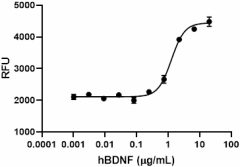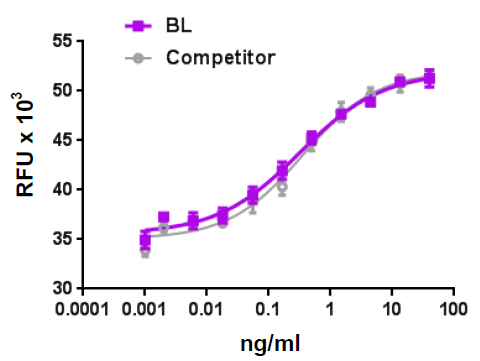- Regulatory Status
- RUO
- Other Names
- Brain-derived neurotrophic factor, ANON2, BLUN2
- Ave. Rating
- Submit a Review
- Product Citations
- 1 publications

| Cat # | Size | Price | Save |
|---|---|---|---|
| 788902 | 10 µg | ¥43,390 | |
| 788904 | 25 µg | ¥72,440 |
Brain-derived neurotrophic factor (BDNF) is the second member of the NGF family of neurotrophic factors (neurotrophins) that includes nerve growth factor (NGF), neurotrophin-3 (NT-3) and neurotrophin-4/5 (NT-4/5). BDNF shares approximately 55% amino acid identity with other family members. The amino acid sequence of mature BDNF is identical in all mammals examined. All neurotrophins are noncovalently linked homodimers and initially produced as proneurotrophins. These proneurotrophins have distinct biological activity different from their mature counterparts. Mature BDNF promotes the survival and differentiation of selected neuronal populations of the peripheral and central nervous systems during development. BDNF participates in axonal growth, pathfinding and in the modulation of dendritic growth and morphology. BDNF is also a major regulator of synaptic transmission and plasticity at adult synapses in many regions of the CNS. High levels of expression of BDNF have been detected in the hippocampus, cerebellum, fetal eye and placenta. BDNF binds with high affinity and specifically activates the TrkB tyrosine kinase receptor.
Product DetailsProduct Details
- Source
- Human BDNF, amino acid His129-Arg247 (Accession # P23560), and Thr at N-terminal was expressed in CHO cells.
- Molecular Mass
- The 120 amino acid recombinant protein has a predicted molecular mass of approximately 13.6 kD. The DTT-reduced protein migrates at approximately 15 kD and the non-reduced protein migrate at approximately 14 kD by SDS-PAGE. The predicted N-terminal amino acid is Thr.
- Purity
- >95%, as determined by Coomassie stained SDS-PAGE.
- Formulation
- 0.22 µm filtered protein solution is in 0.1% TFA, 10% acetonitrile.
- Endotoxin Level
- Less than 0.1 EU per µg protein as determined by the LAL method
- Concentration
- 10 and 25 µg sizes are bottled at 200 µg/mL. 100 µg size and larger sizes are lot-specific and bottled at the concentration indicated on the vial. To obtain lot-specific concentration and expiration, please enter the lot number in our Certificate of Analysis online tool.
- Storage & Handling
- Unopened vial can be stored between 2°C and 8°C for up to 2 weeks, at -20°C for up to six months, or at -70°C or colder until the expiration date. For maximum results, quick spin vial prior to opening. The protein can be aliquoted and stored at -20°C or colder. Stock solutions can also be prepared at 50 - 100 µg/mL in appropriate sterile buffer, carrier protein such as 0.2 - 1% BSA or HSA can be added when preparing the stock solution. Aliquots can be stored between 2°C and 8°C for up to one week and stored at -20°C or colder for up to 3 months. Avoid repeated freeze/thaw cycles.
- Activity
-
The ED50 = 1 - 3 µg/mL as measured by the ability of the protein to induce the proliferation of induce the proliferation of C6 glioma cells.
When human BDNF is immobilized at 1 µg/mL, human TrkB-Fc Chimera (Cat. No. 785002) binds in a dose-dependent manner. The EC50 range for this effect is 40 - 160 ng/mL. - Application
-
Bioassay
- Application Notes
-
BioLegend carrier-free recombinant proteins provided in liquid format are shipped on blue ice. Our comparison testing data indicates that when handled and stored as recommended, the liquid format has equal or better stability and shelf-life compared to commercially available lyophilized proteins after reconstitution. Our liquid proteins are verified in-house to maintain activity after shipping on blue ice and are backed by our 100% satisfaction guarantee. If you have any concerns, contact us at tech@biolegend.com.
- Product Citations
-
Antigen Details
- Structure
- Non-covalently linked homodimer
- Distribution
-
Ubiquitous with high levels in peripheral tissues including prostate, placenta, pancreas, heart, kidney, pituitary gland, lung and testis.
- Function
- Supports the survival of sensory and sympathetic neurons, and also dopaminergic midbrain neurons.
- Interaction
- Sensory neurons, sympathetic neurons, midbrain dopaminergic neurons.
- Ligand/Receptor
- TrkB
- Bioactivity
- Measured by its ability to induce proliferation of C6 glioma cells
- Cell Type
- Neural Stem Cells, Neurons
- Biology Area
- Neurodegeneration, Neuroscience, Stem Cells, Synaptic Biology
- Molecular Family
- Growth Factors
- Antigen References
-
- Baloh RH, et al. 1998. Neuron. 21:1291-302.
- Masure S, et al. 1999. Eur J Biochem. 266:892-902.
- Gardell LR, et al. 2003. Nature Med. 9:1383-9.
- Honma Y, et al. 2002. Neuron. 35:267-82.
- Banerjee A, et al. 2012. PLoS One. 7(11):e50098.
- Wong LE, et al. 2015. Proc Natl Acad Sci USA. 112:6170-5.
- Zhang M, et al. 2016. Oncotarget. 7:3267-82.
- Gene ID
- 627 View all products for this Gene ID
- UniProt
- View information about BDNF on UniProt.org
Related FAQs
- Why choose BioLegend recombinant proteins?
-
• Each lot of product is quality-tested for bioactivity as indicated on the data sheet.
• Greater than 95% Purity or higher, tested on every lot of product.
• 100% Satisfaction Guarantee for quality performance, stability, and consistency.
• Ready-to-use liquid format saves time and reduces challenges associated with reconstitution.
• Bulk and customization available. Contact us.
• Learn more about our Recombinant Proteins. - How does the activity of your recombinant proteins compare to competitors?
-
We quality control each and every lot of recombinant protein. Not only do we check its bioactivity, but we also compare it against other commercially available recombinant proteins. We make sure each recombinant protein’s activity is at least as good as or better than the competition’s. In order to provide you with the best possible product, we ensure that our testing process is rigorous and thorough. If you’re curious and eager to make the switch to BioLegend recombinants, contact your sales representative today!
- What is the specific activity or ED50 of my recombinant protein?
-
The specific activity range of the protein is indicated on the product datasheets. Because the exact activity values on a per unit basis can largely fluctuate depending on a number of factors, including the nature of the assay, cell density, age of cells/passage number, culture media used, and end user technique, the specific activity is best defined as a range and we guarantee the specific activity of all our lots will be within the range indicated on the datasheet. Please note this only applies to recombinants labeled for use in bioassays. ELISA standard recombinant proteins are not recommended for bioassay usage as they are not tested for these applications.
- Have your recombinants been tested for stability?
-
Our testing shows that the recombinant proteins are able to withstand room temperature for a week without losing activity. In addition the recombinant proteins were also found to withstand four cycles of freeze and thaw without losing activity.
- Does specific activity of a recombinant protein vary between lots?
-
Specific activity will vary for each lot and for the type of experiment that is done to validate it, but all passed lots will have activity within the established ED50 range for the product and we guarantee that our products will have lot-to-lot consistency. Please conduct an experiment-specific validation to find the optimal ED50 for your system.
- How do you convert activity as an ED50 in ng/ml to a specific activity in Units/mg?
-
Use formula Specific activity (Units/mg) = 10^6/ ED50 (ng/mL)

















Follow Us